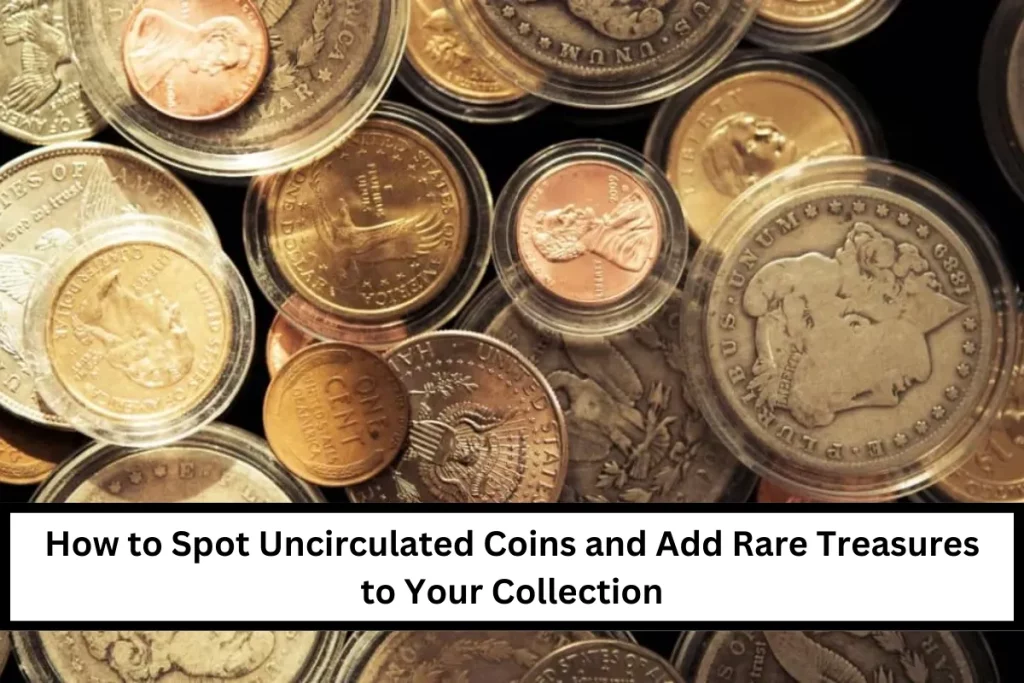When you start collecting coins, one of the most important things to understand is what makes a coin uncirculated. Uncirculated coins are those that have never been used in everyday transactions and maintain their original mint condition.
These coins are highly valued by collectors due to their pristine quality, and identifying them can be tricky if you’re new to the hobby. Here’s a guide on how to identify uncirculated coins and what to look for.
What Are Uncirculated Coins?
Uncirculated coins are freshly minted coins that haven’t been circulated as currency. They are typically shiny, with no signs of wear or damage. These coins are usually collected straight from the mint and are considered to be in their perfect form.
- Minting Process: Uncirculated coins come directly from the U.S. Mint without being used for transactions.
- Pristine Condition: They are free of any damage or marks.
- Collectible Value: Collectors prize uncirculated coins for their rarity and condition.
Key Characteristics of Uncirculated Coins
Uncirculated coins may look similar to regular coins, but there are specific features that set them apart. Here’s a breakdown of what to look for:
1. No Signs of Wear
One of the easiest ways to identify uncirculated coins is by checking for any signs of wear. If the coin looks used or worn down, it’s not uncirculated. Look for:
- Sharp Edges: Uncirculated coins have sharp, clean edges that show no signs of being handled.
- Lustrous Surface: The surface of the coin will have a shiny, almost mirror-like appearance without any dullness.
2. Crisp Detailing
Another important characteristic is the detailing of the design on the coin. Uncirculated coins have clearly defined features, including:
- Clear Date: The date on the coin will be distinct, with no fading or blurring.
- Defined Design: The designs, such as portraits and inscriptions, will be sharp and well-defined.
3. No Scratches or Dents
Coins that have been circulated often show scratches or dents from handling. Uncirculated coins, on the other hand, should be flawless. Inspect the coin carefully for any imperfections such as:
- Scratches: Coins with visible scratches are not considered uncirculated.
- Dents: A dented coin is a clear sign it’s been in circulation.
4. The Shine
One of the most obvious features of uncirculated coins is their shine. A well-maintained uncirculated coin will have a glossy, reflective surface due to the minting process. This shine will start to fade if the coin has been circulated.
5. Inspect the Packaging
If you’re unsure about a coin’s condition, check the packaging. Uncirculated coins are often sold in protective cases to prevent damage. These cases can help maintain the coin’s pristine condition over time.
How to Identify Uncirculated Coins in Your Collection
If you have a collection of coins and want to identify which ones are uncirculated, there are several steps you can follow:
Step 1: Examine the Coin’s Surface
Start by closely examining the surface of the coin. Look for any signs of wear, scratches, or discoloration. If the coin looks clean and shiny, it may be uncirculated.
Step 2: Use Magnification
Using a magnifying glass can help you spot small details on the coin that might be hard to see with the naked eye. Look for:
- Detailed Inscriptions: Examine the coin’s edges and text for clear, sharp details.
- Surface Quality: Check for any imperfections or wear on the design.
Step 3: Check for Mint Marks
Many uncirculated coins have mint marks that can help identify their origin. Check the location of the mint mark, which can typically be found on the reverse of the coin, to confirm its authenticity.
- Mint Mark Location: On many U.S. coins, the mint mark is found near the bottom of the reverse side.
- Mint Mark Type: Common mint marks include “D” for Denver, “S” for San Francisco, and “P” for Philadelphia.
Step 4: Consult a Professional
If you’re still unsure whether a coin is uncirculated, it may be worth consulting a professional. Coin experts and appraisers can verify the coin’s authenticity and condition.
FAQs
1. How do I know if a coin is uncirculated?
You can identify uncirculated coins by their sharp edges, shiny surface, and well-defined details.
2. Can uncirculated coins lose value?
While they may lose some value over time, well-preserved uncirculated coins typically retain their worth.
3. Why are uncirculated coins valuable?
They are rare and often more perfect than coins that have been used in everyday transactions, making them valuable to collectors.
4. How should I store uncirculated coins?
Store uncirculated coins in protective cases or holders to prevent any damage and preserve their quality.
5. Can I sell uncirculated coins?
Yes, you can sell uncirculated coins to collectors or through online marketplaces at a higher value than circulated coins.

